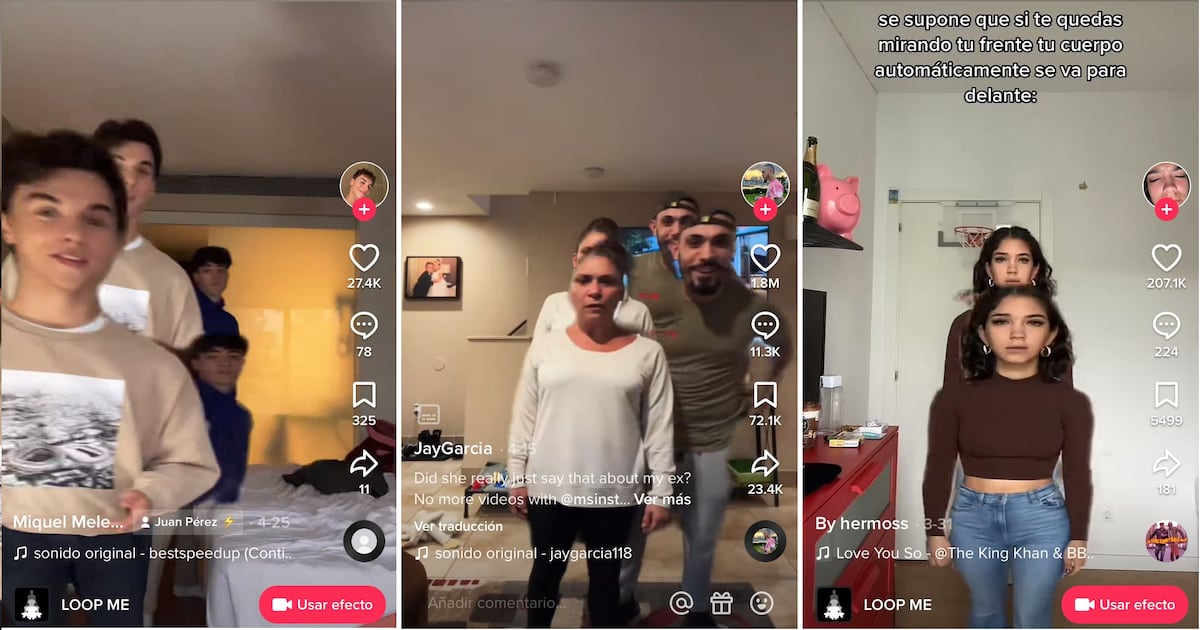[This piece corresponds to one of the shipments of Verne's fortnightly newsletter, by Anabel Bueno and Pablo Cantó.
If you want to subscribe, you can do it
through this link
]
.
Instagram and TikTok filters can make our selfies appear cat ears, princess crowns, bulging eyes... And, in the case of the filter called
Loop me
, until we get dizzy and even fall.
This filter, which simulates that we fall to the ground in a loop, over and over again, has been used in more than 35,000 videos on TikTok alone, many of which have over a million views.
The reason for success?
Although nothing happens in most videos, some people say that while using the filter, they have gotten dizzy or even fell.
Many of the videos that have become most popular include these falls, like this one, created by the author of the filter himself and which compiles some of the publications with this effect that have been seen the most in recent months.
But why does this happen?
What is true and what is pantomime?
We have tested the filter –many, many times– and we have spoken with three experts who have also tried it: Susana Martínez, director of the Neuroscience laboratory at New York University and an expert in optical illusions;
Rocío González, otolaryngologist specializing in balance disorders at the Ennequilibrio clinic;
and Rodrigo Castillejos Carrasco-Muñoz, Physiotherapist in the Balance Unit of the Ear Nose and Throat Institute of Madrid.
They have also had the interest and kindness to do tests with their family and friends.
These are their conclusions.
Our tests: few falls, quite a lot of dizziness
Neither Susana Martínez, nor Rocío González, nor their family and friends who have tried it have fallen while using the filter, although several of them do claim to have felt dizzy.
I, for my part, have tried it sitting, standing, squatting, in daylight, in the dark... And I have gotten very dizzy, but I have only been about to fall in very special conditions: while standing in front of the mobile with an open plane (I could see my body almost completely) and leaning slightly forward.
In that test my knees gave out and, if I hadn't put my hands on a table, I would have fallen.
Castillejos Carrasco-Muñoz also claims to have had that feeling, without reaching the ground.
"It may work for some people, but the filter is not an extrapolable and reproducible experiment," considers Martínez, although she admits that she felt "some dizzyness."
If before continuing reading you want to try it yourself, you can do it through this link to use the filter on TikTok:
Why can it happen?
Why not everyone?
To explain why this can happen, we first have to understand how our sense of balance works: "It's a three-legged stool: legs, vision and inner ear," explains Rocío González.
"If one of these fails, we are more unstable."
In this case, Castillejos Carrasco-Muñoz points out that it is due to optical flow, the sliding of images on the retina that occurs, for example, when moving the head to one side or when we are on a stopped train, another train starts on the next platform and we doubt which of the two is the one that has moved.
“The organism uses the optical flow to anticipate movements, distribute the muscle tone of the body and keep us in balance”, he explains.
“The filter produces a slide of the image from top to bottom, the same that we see when, for example, we get up, which makes the muscle tone go to the posterior muscles [extensors of the spine, buttocks, etc].
The anterior part loses tone and has a tendency to fall forward.
Both González and Castillejos Carrasco-Muñoz explain that these types of visual effects are used in the rehabilitation of people with balance problems.
Here you can see an example.
Another reason that can lead to a stumbling block when using the 'Loop me' filter is our expectations: these influence our senses and, in general, we expect a
selfie
to reflect a true image of ourselves, not one in which we fall towards ahead.
"There are a series of optical illusions that are based on mirrors and the expectations of what we expect to see in them," Susana Martínez points out about this possibility, and gives as an example of this type of optical illusions the mirror therapy of the psychologist and neuroscientist VS Ramachandran.
If you are interested, Ramachandran himself explained it in this talk (from 10:45)
Regarding why it affects some people more than others, González gives as an example "What happens in cars or boats, there are those who get dizzy and it will happen often, and those who almost never get dizzy".
Both she and Castillejos Carrasco-Muñoz point out that it may be related to "excessive visual dependence, that is, when the organism prioritizes visual information and, when it is not of good quality and cannot be codified normally [as in movement patterns that are repeated, as in the case of the filter], it produces dizziness”.
You can follow
EL PAÍS TECNOLOGÍA
on
and
or sign up here to receive our
weekly newsletter
.

